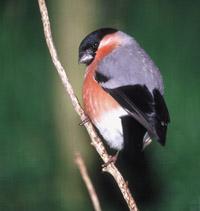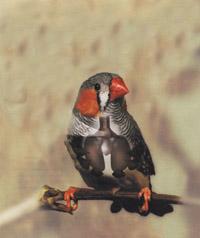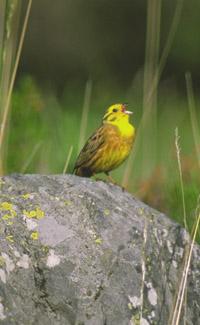Looking for the secret of bird singing

If we immersed ourselves in any of the encyclopedias of the 70s in search of an answer, we would get little clean. Even if it seems a lie, it is not a decade that biologists are able to give adequate explanations about the mechanism of bird singing. In recent years researchers have managed to sing with birds stopping the beak and with a fiber optic endoscope in the throat, even in the atmosphere of helium. They have measured their breathing and analyzed the activity of the throat muscles with the result that birds capable of singing have a common characteristic, two voice boxes. Thanks to this they are able to do two things at once, for example, a duet with itself. However, there are still many questions in the air, such as how birds can sing so high.
The explanation for this scarcity of information is found in the voice organ of the birds, the siring. In mammals the larynx is attached to the nose, which facilitates the work of researchers, but the siring of birds is well kept in the body. Birds do not breathe like mammals. Like bellows, they have air bags that propel air through the lungs; and surrounded by one of these bags, between a surrounding muscle flap, is the walnut siringe. Above it would be the size of a small pea. Understandable, therefore, difficulties in analyzing it!
Researchers have also seen that birds that are unable to sing, such as duck, chicken, or parrots, have the siringe in the trachea, just before it branches into the bronchi that go to the lungs. On the contrary, birds with the ability to sing, such as gossips, fins or sparrows, have a lower double structure, covering the two bronchi.
Taking advantage of duplicity
The location of the siringe has prevented its observation for years. Consequently, researchers have had to use indirect approaches, such as cutting a muscle and its influence on bird singing. Quite resistant methods. However, in 1990, Roderick Suthers, physiologist at Bloomington Indiana University, attempted a new and smoother approach: the implantation by surgery of a small tool to measure airflow in the bronchi of birds. Thus, when a few days later the birds resumed singing, Roderick Suthers was able to know which tubes the birds came from. Similar essays have since shown that birds, thanks to the folding of the siring, have several tricks to create complex songs.
Some are able to form authentic duets, using both voices at the same time. In one of the tubes of the siringe they can create a growing note, while in the other they produce a descent, thus forming very harmonic songs. Others alternately use both tubes. In this way they will release one note after another, quickly and continuously. Many birds use the two siring tubes as a speaker. The left is formed in low notes and the right in high notes. The cardinal, for example, produces a note that gently climbs from one kilohercilla to seven, and passes right through the left tube to about 3.5 kilohertz. However, there are no large dimensional or structural differences between the two siring tubes. Apparently, the key to this skill lies in the different forces exercised on each side.

Suthers made a curious discovery in the use that the canaries have given to the duplicity of the siringe: while breathing on the right they sing on the left. The two lung bags of the birds are joined together, so even if they breathe on one side, they can fill the two lung bags with air. This division of work allows the canaries to release long song sequences of 30 "syllables" in a row, but also to create short sound segments per second. And so that they are not without air, after each "syllable" they make a quick inspiration. The goal is to achieve speed in chanting. And why? Well, there are recent studies in which canary females prefer males able to sing fast.
From birds to humans
Although scientists have begun to understand the use of siring birds, they still know nothing about how to create sounds. Two have been the main theories for years. According to one, the birds would produce sounds by passing the air through a narrowing of the siringe. The other theory holds that the sounds come from the vibration of a membrane in the form of a tympanum perpendicular to the tubes of the syinge. A couple of years ago, however, Franz Goller of the University of Utah and Ole Larsen of Odense University of Denmark made an unexpected discovery. By inserting the fiber optic endoscope into a bird's throat, the moment the bird sang, they managed to observe the siringe. The conclusion is that the siring works very similar to the human vocal apparatus. During chanting, the throat muscles place two heavy fabric folds, the outer and inner lips, on the airway and subject them to vibration during the passage of the air, as with the vocal cords in the human throat. In addition, despite removing the eardrum membrane from the siring, supposedly the origin of the sound, they saw that the influence on bird singing was very small.
Michale Fe, in a later investigation using a kind of camera, obtained a different result: the only group of tissues vibrated with this membrane. In this study, however, no living bird was studied, but the siringe extracted from a txonta. Siringe with normal muscle tension. The Lucent Technologies' Bell Laboratories team at Fee in New Jersey also made another observation. It seems that sometimes the bird siring works automatically. In the song of the txonta there are times when the song goes from a clean melody to a bustling din on the return round. The siringe extracted from Fe showed the same transitions when air was circulated at increasing speed through the tubes. This suggests that some of the richness of txonta chanting may be the result of simple changes in airflow and not complex brain operations.

But since the siringe is a sound source, the throat and mouth of the bird have much to do with the song that will reach our ears. The resonances generated in these two mediums can drastically alter the initial sound. This effect is also evident in the human voice. Thanks to the throats, mouths and teeth we form vowels and consonants. These intermediaries are, in turn, one of the main causes of timbres inequality in which the voice itself is unique. For the same reasons, when speaking in the helium atmosphere, we will have a higher tone of voice than usual. Being the lightest helium than air, it transports the sound faster and highlights in the mouth resonances of tone higher than normal, although the frequency of vibration in the vocal chords varies little from medium to medium.
Something similar happens to birds. Ten years ago the ethologist Stephen Nowiki put the birds of nine different families in an atmosphere enriched with helium and recorded his song. In all cases he collected high frequency tones, such as pylon songs, which did not appear when birds sang in the air atmosphere. Based on these results he postulated that the ceiling of the peak acts as a filter. It is a space that allows to create relatively pure melodies amplifying the sounds produced by the siringe. But given that in the singing of many birds, jumps abound from one octave to another, they have to adapt the filter constantly to create the right melody at every moment. Analyzing the singing of sparrows, the researchers realized that they open the peak more when throwing high notes, as they manage to reduce strangulation and create more frequent resonance.
In later studies, the Nowiki team analyzed how the sounds produced would be keeping the beak of sparrows open to a fixed measure. For this, for a few days and in a few moments, they put the beak to the hats, until the birds had the beak in that position and could start singing. In the songs thus collected high tones appeared more often than otherwise.
The Nowiki team also analyzed how sparrows come together to use siring, throat and beak. In the first steps, young birds learn to properly carry the melody and rhythm of the notes, and in the end, to compose pure notes using the integrity of the vocal apparatus.
All these apparently entirely academic investigations acquire a new dimension as the bird voice system is similar to that of humans. Michale Fe believes we could learn about the human vocal apparatus by analyzing the bird's siring. According to his arguments, if attempts at artificial representation of the human voice have failed, it is because we do not know the vocal apparatus well, at least in part.
Mr. Fee be right or wrong, at least the next time you go to the mountain, be attentive to what the ear says. You may be able to distinguish unknown young txolarre from where they are singing.





